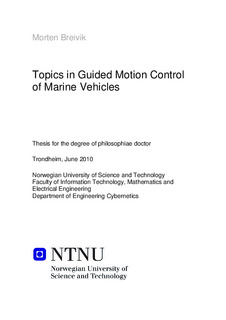| dc.contributor.author | Breivik, Morten | nb_NO |
| dc.date.accessioned | 2014-12-19T14:01:11Z | |
| dc.date.available | 2014-12-19T14:01:11Z | |
| dc.date.created | 2010-06-17 | nb_NO |
| dc.date.issued | 2010 | nb_NO |
| dc.identifier | 325139 | nb_NO |
| dc.identifier.isbn | 978-82-471-2084-2 (printed ver.) | nb_NO |
| dc.identifier.isbn | 978-82-471-2085-9 (electronic ver.) | nb_NO |
| dc.identifier.uri | http://hdl.handle.net/11250/259494 | |
| dc.description.abstract | A mix between a monograph and an article collection, this PhD thesis considers the concept of guided motion control for marine vehicles, in particular focusing on underactuated marine surface vehicles. The motion control scheme is defined to involve the combination of a guidance system which issues meaningful velocity commands with a velocity control system which has been specifically designed to take vehicle maneuverability and agility constraints into account when fulfilling these commands such that a given motion control objective can be achieved in a controlled and feasible manner without driving the vehicle actuators to saturation.
Furthermore, motion control scenarios are classified in a novel way according to whether they involve desired motion which has been defined a priori or not. Consequently, in addition to the classical scenarios of point stabilization, trajectory tracking, path following and maneuvering, the so-called target tracking scenario is considered. The resulting scenarios then involve target tracking, path following, path tracking and path maneuvering. In addition, it is proposed to define the control objectives associated with each scenario as work-space tasks instead of configurationspace tasks. Such a choice seems better suited for practical applications, since most vehicles operate in an underactuated configuration exposed to some kind of environmental disturbances.
The thesis also proposes a novel mechanization of constant bearing guidance, which is a classical guidance principle well-known in the guided missile literature. This suggestion is motivated by a need to solve the target tracking motion control objective for marine vehicles. The proposed implementation enables explicit specification of the transient rendezvous behavior toward the target by selection of two intuitive tuning parameters.
In addition, a singularity-free guidance law applicable to path following scenarios involving regularly parameterized paths which do not need to be arc-length parameterized is proposed. An extension to this guidance law is also suggested in order to enable off-path traversing of regularly parameterized paths for formation control purposes.
A novel velocity control system which inherently takes maneuverability, agility and actuator constraints into account is developed for the purpose of controlling underactuated marine vehicles moving at high speed. The system is derived through a design method which involves a control-oriented modeling approach and requires a minimum of system identification tests to be carried out.
The thesis also gives a novel overview of the major developments in marine control systems as seen from a Norwegian perspective. The development can be viewed as three waves of control, where the first wave concerned development of novel ship automation technology in the 1960s and 1970s, the second wave involved development of unique dynamic positioning systems in the 1970s and 1980s, while the third wave is expected to encompass the development of unmanned vehicle technology for a large number of maritime applications.
A summary of the historical development, present status and future possibilities associated with unmanned surface vehicles (USVs) is also given. Current Norwegian activities are particularly emphasized.
Furthermore, an overview of the main formation control concepts applicable to marine surface vehicles is given. A novel formation control functionality named coordinated target tracking is subsequently suggested within a leader-follower framework. Employing a guided motion control system using the suggested mechanization of constant bearing guidance, this functionality is then implemented for two different types of underactuated USVs such that they are able to move in formation with a leader vessel which can maneuver freely without being constrained to any predefined motion pattern.
In particular, excerpts from successful full-scale formation control experiments involving a manned leader vessel and the two USVs executing coordinated target tracking at high speed are presented. This functionality currently seems to be unique on a worldwide basis, providing a convenient plug-and-play formation control capability for manned leader vessels involved in maritime survey operations. | nb_NO |
| dc.language | eng | nb_NO |
| dc.publisher | NTNU | nb_NO |
| dc.relation.ispartofseries | Doctoral Theses at NTNU, 1503-8181; 2010:63 | nb_NO |
| dc.relation.haspart | Breivik, M; Fossen, T.I.. A unified concept for controlling a marine surface vessel through the entire speed envelope. Intelligent Control, 2005. Proceedings of the 2005 IEEE International Symposium on, Mediterrean Conference on Control and Automation: 1518-1523, 2005. <a href='http://dx.doi.org/10.1109/.2005.1469807'>10.1109/.2005.1469807</a>. | nb_NO |
| dc.relation.haspart | Breivik, Morten. Marine Craft: 21st CenturyMotion Control Concepts. Sea Technology. (ISSN 0093-3651). 47(3): 33-36, 2006. | nb_NO |
| dc.relation.haspart | Breivik, Morten; Fossen, Thor I.. Motion Control Concepts for Trajectory Tracking of Fully Actuated Ships. IFAC Proceedings series, 2006. | nb_NO |
| dc.title | Topics in Guided Motion Control of Marine Vehicles | nb_NO |
| dc.type | Doctoral thesis | nb_NO |
| dc.source.pagenumber | 226 | nb_NO |
| dc.contributor.department | Norges teknisk-naturvitenskapelige universitet, Fakultet for informasjonsteknologi, matematikk og elektroteknikk, Institutt for teknisk kybernetikk | nb_NO |
